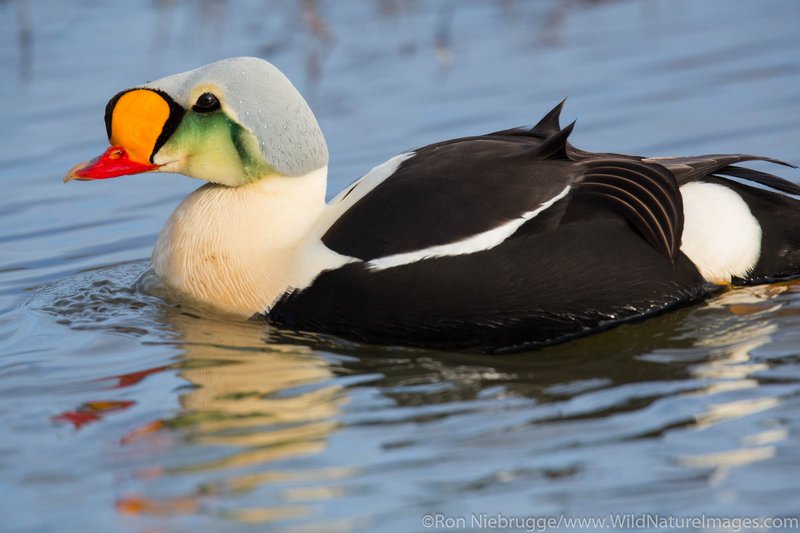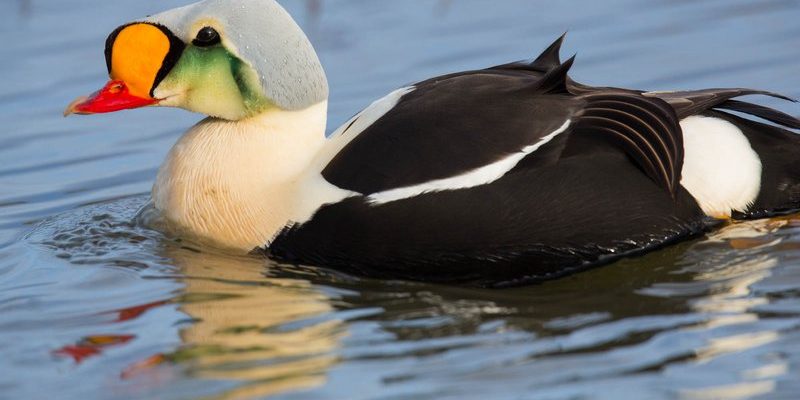
The King Eider is a magnificent sea duck that stands out in the avian world. Imagine a bird so vibrant that it seems to be wearing nature’s finest colors. With its bold markings and striking features, this bird captivates everyone lucky enough to spot it in the wild. Often found in the cold waters of the Arctic, the King Eider is not just a pretty face; it’s a fascinating creature with unique behaviors and adaptations.
You might be wondering what makes the King Eider so special. For starters, they are known for their impressive migrations and social behavior. These ducks are the largest of the eider family and are renowned for their striking appearance, particularly the males, which boast a dazzling display of colors. From their fluffy down feathers to their powerful swimming abilities, there’s so much more to learn about these beautiful birds.
Physical Characteristics
The King Eider exhibits a range of distinct physical traits that help it thrive in its Arctic environment. Males, or drakes, are particularly eye-catching with their unique plumage. They have a mix of black, white, and striking pale blue. Their large, rounded heads feature a prominent orange lump on the forehead, making them easily identifiable even from a distance. Female King Eiders, on the other hand, are more muted in color, sporting a mottled brown appearance that helps them blend into their surroundings, especially while nesting.
When it comes to size, the King Eider is a hefty bird. Adult males can weigh anywhere from 2.5 to 3.5 kg (about 5.5 to 7.7 lbs) and measure approximately 50 to 68 cm (19.5 to 26.5 inches) in length. Females tend to be slightly smaller. Their wingspan can reach up to 90 cm (35 inches), giving them a commanding presence on the water. This impressive size is essential for their lifestyle, as they dive deep to catch food and navigate their icy habitats.
Habitat and Range
The King Eider is primarily found in the frigid waters of the Arctic and sub-Arctic regions. They prefer coastal areas where they spend their time foraging for food. You might find them in bays, estuaries, and near ice edges during the winter months, where they gather in large groups. Their breeding grounds are typically located on the tundra, where they favor sites near water bodies. After breeding, these birds migrate vast distances to reach their wintering grounds, often traveling as far south as the northeastern United States and Canada.
During winter, King Eiders are often seen in flocks, floating serenely on the water’s surface. The communal lifestyle not only provides safety in numbers but also enhances their foraging efficiency. They dive together, searching for clams, mollusks, and small fish, making them skilled and social hunters.
Diet and Feeding Habits
The diet of the King Eider varies according to the season. During the breeding season, they mainly feed on plant materials found in their tundra habitats. However, their true culinary preferences come to life during winter when they are primarily diving for shellfish. A typical meal might consist of clams, crabs, and various crustaceans. They are excellent divers and can plunge to depths of up to 30 meters (about 100 feet) to snag their prey.
Here’s the thing: these ducks have a fascinating foraging technique. They can use their bill to sift through sand and mud to find hidden morsels. This behavior is not just impressive; it’s a critical survival skill that allows them to make the most of their environment. With their keen eyesight and specialized diving abilities, King Eiders efficiently locate food even in challenging conditions.
Breeding and Nesting
When spring arrives, the King Eider returns to its Arctic breeding grounds, where dramatic changes unfold. The courtship rituals of male King Eiders are particularly captivating. Males display their vibrant plumage, engaging in elaborate displays to attract females. They perform synchronized swimming and various vocalizations that sound like soft whistles or croaks, creating a beautiful melody across the icy waters.
Once paired, the female builds a nest, usually hidden among the vegetation near water. The nest is a cozy bowl made of down and grasses, providing a soft spot for the eggs. On average, a female lays about 4 to 6 eggs and tends to them diligently. After approximately 28 days, the eggs hatch, and the ducklings make their way to the water, where they’ll start foraging almost immediately. This early independence is crucial, as it allows them to develop their skills and adapt quickly to their environment.
Conservation Status
The conservation status of the King Eider has raised concerns among ornithologists and nature enthusiasts alike. As climate change continues to impact Arctic habitats, these birds face many challenges, including habitat loss and food scarcity. While they are currently classified as “Least Concern,” ongoing research is essential to monitor their populations closely. Changes in sea ice patterns can disrupt their breeding and feeding grounds, potentially leading to declines in numbers.
Conservation efforts are underway to protect the delicate ecosystems these birds depend on. Protecting their nesting sites and ensuring the health of marine habitats can help maintain stable populations. Additionally, public awareness campaigns can encourage responsible practices among locals and visitors alike, ensuring that our feathered friends continue to thrive in their natural habitats.
Fun Facts About King Eiders
- King Eiders can dive for food for up to a minute without surfacing.
- They are social birds that often gather in large flocks during winter.
- The males have distinctive vocalizations that add to their charming personalities.
- These birds can live up to 20 years in the wild under optimal conditions.
Behavior and Social Structure
The King Eider’s behavior is just as fascinating as its physical traits. These ducks are highly social birds, often found in large groups, especially during migration. Their social structure plays a vital role in their survival. By foraging together, they can efficiently locate food and protect themselves from predators. It’s common to see them floating in groups on the water, communicating with each other through soft calls and synchronized movements.
During their breeding season, males become territorial and may engage in displays of aggression to defend their space. However, outside of the breeding season, they exhibit a more cooperative spirit, often forming mixed-species flocks with other diving ducks. This adaptability demonstrates their complex social dynamics and the importance of community for survival.
Migration Patterns
Migratory birds are always a wonder to observe, and the King Eider is no exception. Each year, these ducks embark on an incredible journey to escape the harsh Arctic winter. Migrating in large flocks, they travel thousands of miles to reach their wintering grounds. It’s a demanding trek that requires stamina and precision. Their migration routes usually follow coastal lines, where they can find food and safe resting spots.
You might be curious about how they navigate such long distances. Like many migratory birds, King Eiders rely on the sun, stars, and Earth’s magnetic field for guidance. Their ability to return to the same breeding grounds year after year is a testament to their remarkable navigation skills. This annual journey is not just a quest for food; it’s integral to their life cycle, allowing them to breed in the best possible conditions.
Interacting with King Eiders
If you’re lucky enough to encounter a King Eider in the wild, consider it a gift. Observing these beautiful birds in their natural habitat can be a thrilling experience. When watching them, try to keep a respectful distance, as getting too close can disrupt their feeding or breeding activities. Bring binoculars for a closer look, and take the time to appreciate their unique behaviors.
Many birdwatching spots along the coasts offer opportunities to see King Eiders during migration. Participating in guided tours led by knowledgeable birders can enhance your experience. These experts can provide valuable insights about the birds’ behaviors and habitats, creating a richer connection. Remember to dress warmly if you’re venturing out in colder seasons—after all, these ducks have a better tolerance for the chill than we do!
King Eiders in Popular Culture
The King Eider, with its striking appearance and unique behaviors, has captured the interest of many nature lovers and artists. Its vibrant colors often inspire artists, photographers, and nature enthusiasts who want to capture the essence of the wild. Additionally, its presence in folklore and literature reflects humanity’s fascination with the natural world. Many cultures view the King Eider as a symbol of the wilderness and the resilience of life in harsh conditions.
In various documentaries and nature programs, King Eiders are portrayed, showcasing their majestic beauty and the challenges they face in their environment. These portrayals can inspire conservation efforts, as viewers are often moved by the story of such incredible creatures. By sharing their stories, we help raise awareness about their plight and the importance of preserving their habitats for future generations.
FAQ
What does the King Eider eat?
The King Eider primarily feeds on mollusks, crustaceans, and aquatic plants. In summer, they may consume a variety of plant materials available in their Arctic breeding grounds. A typical meal often includes clams and small fish, which they skillfully dive to catch under the water’s surface.
Where can you find King Eiders?
King Eiders are found in the Arctic and sub-Arctic regions, often inhabiting coastal areas, bays, and estuaries during winter. Their breeding grounds are usually near tundra ponds and lakes. After the breeding season, they migrate southward, reaching areas like northeastern Canada and the eastern United States.
Are King Eiders endangered?
Currently, King Eiders are classified as “Least Concern.” However, they face threats from climate change and habitat loss. Active conservation efforts are essential to monitor their populations and protect their crucial habitats to ensure their survival in the wild.
How do King Eiders communicate?
King Eiders use a range of vocalizations to communicate with each other. Males produce soft whistles or croaks, particularly during courtship displays. These calls are an essential part of their social structure, helping them establish territory and attract mates in their breeding season.
What are the breeding habits of King Eiders?
King Eiders typically mate in the spring, with males performing elaborate courtship displays to attract females. After mating, females build nests on the tundra near water bodies, laying 4 to 6 eggs. They incubate the eggs for about 28 days before the ducklings hatch and quickly begin foraging for food.
How long do King Eiders live?
In the wild, King Eiders can live up to 20 years, although the average lifespan may be lower due to predation and environmental factors. Their longevity speaks to their adaptability and the importance of healthy habitats for their survival.
What adaptations do King Eiders have for cold environments?
King Eiders are well adapted to their frigid habitats. They have a thick layer of insulating feathers that traps warmth and helps them survive in extreme cold. Additionally, their buoyant bodies and webbed feet make them excellent swimmers, allowing for efficient foraging in icy waters.
Can King Eiders be found in captivity?
While King Eiders are primarily wild birds, they can be found in some zoos and wildlife sanctuaries. These facilities aim to educate the public about their natural behaviors and conservation needs. However, breeding and keeping them in captivity requires specialized care to mimic their natural environments as closely as possible.
What threats do King Eiders face?
King Eiders face several threats, including climate change, habitat loss, and pollution. Changes in sea ice patterns can impact their breeding and feeding habitats, potentially causing population declines. Additionally, hunting and human disturbances pose significant risks to their survival.
How do King Eiders contribute to their ecosystem?
As consumers in their ecosystems, King Eiders play a vital role in maintaining the health of marine environments. By feeding on shellfish and other marine organisms, they help regulate populations of these species. Their presence is an essential indicator of ecosystem health, reflecting the balance of marine food webs.

